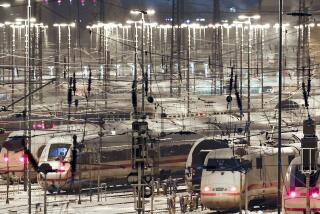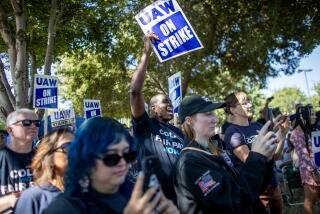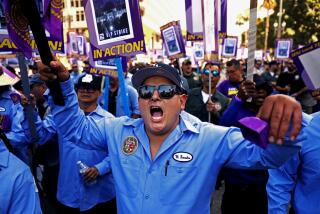Rail Strike Creates N.Y. Nightmare
- Share via
NEW YORK — Tens of thousands of irate commuters inched through traffic jams into Manhattan Tuesday as snow, icy roads and a clogged tunnel turned the first full business day of a strike by Long Island Rail Road employees into a nightmare for many travelers.
Some veterans of a six-day walkout by LIRR workers in 1979 abandoned commuting completely and camped in hotel rooms, which were scarce. Others awoke before dawn to drive to work or to outlying subway stations. Corporations organized car pools, chartered buses and reserved blocks of hotel rooms.
The anger of many travelers was summed up by Paul Levett, a creative director in a Manhattan advertising agency, who was forced to stay in a hotel, away from his family. “Long Island commuters are like an animal that evolves in a sewer of transportation,” said Levett, who still remembers the time he spent 11 hours in a train during an ice storm because the switches were frozen. “ . . . We can’t strike the railroad, and the railroad can strike us.”
Circuitous Route
Stacy Schreider, an employee of a Manhattan bank, said: “It took me 2 1/2 hours. My train ride is usually 40 minutes. I drove out of my way into Brooklyn and then I doubled back and took the subway into Manhattan.”
Her trip brought her to a decision. “I am going to bop around from friend to friend until they are sick of me,” she said. “I am scared of being stranded.”
The three-day strike by eight unions representing about 1,700 of the railroad’s 6,600 unionized workers has stopped all service on the nation’s busiest commuter railroad.
Traffic was light Monday because it was a federal holiday in honor of Dr. Martin Luther King Jr. But the first full business day Tuesday came just as the city and suburbs were recovering from snow and ice.
Weather Causes Problems
Sanitation crews had worked through the night clearing roads before the morning rush hour, but the weather still caused major difficulties. A collision in the Queens Midtown Tunnel snarled traffic. Icing closed lanes on two bridges leading into Manhattan.
Michael Horodniceanu, New York City’s traffic commissioner, said traffic was up by 20% at the city line. On the Long Island Expressway and other major parkways cars moved bumper-to-bumper.
“It’s hard to say which is worse, the weather or the strike,” Horodniceanu said.
After the walkout began Sunday, the unions rejected a proposal for a 28-day cooling-off period to be followed by binding arbitration.
Any settlement will be complicated by the number of unions involved. Issues include wages, medical benefits, pensions and sick leave. The railroad workers make an average of $31,190 under the old contract.
Early Trip Home
For some employees, the trip home--after the long journey into the office-- began soon after lunchtime.
“I am meeting three women on the subway station,” said Joan Rowland, a secretary at Dun & Bradstreet Corp. “We have to go to Main Street, Flushing. I have my car parked in a garage there. I got in at 7:30 a.m.”
Ira Lee Sorkin, a Manhattan lawyer, was among those who got up earlier than usual to begin the trek from suburbia to a subway station.
“I drove to Jamaica, parked my car on the street and I hope I don’t get a ticket,” he said. “The street I used was dug up. The roads were under construction. You had to compete with extra buses, bulldozers and cranes. Crossing the North Pole by dog sled would have been easier.”
More to Read
Sign up for Essential California
The most important California stories and recommendations in your inbox every morning.
You may occasionally receive promotional content from the Los Angeles Times.










